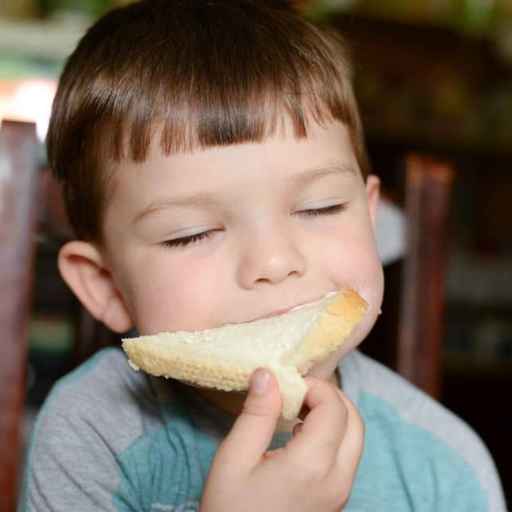
Adding solid food to your baby’s diet is very important, but the first step is ensuring your baby is well protected. In this general guide, we aim to identify how bread presents some concerns as a potential choking hazard for babies and how such problems can be mitigated by suggesting what types of bread can be eaten at a tender age. We will also look at the various characteristics that can contribute to the risks of choking from the different types of bread, including texture and size, and describe in detail how to prepare and serve bread to minimize these hazards. While bread may not be a prominent portion of the diet at this stage, it is crucial to address what types of bread one may consider feeding babies. This additional focus will be particularly relevant for parents concerned with offering their children a variety of foods. In any case, this article confirms and clarifies ideas concerning changes in the child’s diets toward healthy options such as bread.
 Bread for babies has to be safe and nutritious at the same time. The bread that is less sticky and more firmly baked, such as toasted whole grain or rye bread, is acceptable. These will not bond into a pasty mass in the mouth, which may cause choking. Do not use soft white bread; instead, use whole grain because it contains vitamins and fibers and helps enhance chewing muscular strength. It would be better to avoid coarsely ground bread containing seeds and nuts because they may cause allergies and choking. Ensure you introduce the bread in modest quantities to babies while watching for intolerance or allergy. For safe and healthy nutrition, the bread should be appropriate to the age and development of the child.
Bread for babies has to be safe and nutritious at the same time. The bread that is less sticky and more firmly baked, such as toasted whole grain or rye bread, is acceptable. These will not bond into a pasty mass in the mouth, which may cause choking. Do not use soft white bread; instead, use whole grain because it contains vitamins and fibers and helps enhance chewing muscular strength. It would be better to avoid coarsely ground bread containing seeds and nuts because they may cause allergies and choking. Ensure you introduce the bread in modest quantities to babies while watching for intolerance or allergy. For safe and healthy nutrition, the bread should be appropriate to the age and development of the child.
 When introducing bread to babies, caution and proper timing should be prioritized. Start with a loose, toasted whole grain bread to avoid choking hazards. The bread can be cut into 1-inch (2.5 cm) strips so your baby can chew properly. Serve these pieces in portions until the baby has thoroughly chewed the pieces, and do not leave the baby unattended during mealtime. Pay attention to any signs of intolerances or allergic reactions, and take your baby to a pediatrician for that concern. Following such recommendations will ensure your baby’s developmental and nutritional needs are met without compromising their safety.
When introducing bread to babies, caution and proper timing should be prioritized. Start with a loose, toasted whole grain bread to avoid choking hazards. The bread can be cut into 1-inch (2.5 cm) strips so your baby can chew properly. Serve these pieces in portions until the baby has thoroughly chewed the pieces, and do not leave the baby unattended during mealtime. Pay attention to any signs of intolerances or allergic reactions, and take your baby to a pediatrician for that concern. Following such recommendations will ensure your baby’s developmental and nutritional needs are met without compromising their safety.
 When employed correctly, bread can also have several advantages when added to your baby’s menu. First, it is a source of the critical carbohydrate that provides energy that your baby needs to perform daily tasks and is growing. Gradually, whole grain bread can offer dietary fiber, which helps digestion and increases the time it takes to introduce their baby to solids. Enriched bread can also provide iron and B vitamins essential in growth and development. Bread, when mixed with other food groups, increases the diversity and balance of your infant’s meals, enabling him or her to develop a more versatile and complex sense of taste. Always ensure that the bread is free of allergens and is introduced carefully, considering your child’s dietary restrictions and eating habits.
When employed correctly, bread can also have several advantages when added to your baby’s menu. First, it is a source of the critical carbohydrate that provides energy that your baby needs to perform daily tasks and is growing. Gradually, whole grain bread can offer dietary fiber, which helps digestion and increases the time it takes to introduce their baby to solids. Enriched bread can also provide iron and B vitamins essential in growth and development. Bread, when mixed with other food groups, increases the diversity and balance of your infant’s meals, enabling him or her to develop a more versatile and complex sense of taste. Always ensure that the bread is free of allergens and is introduced carefully, considering your child’s dietary restrictions and eating habits.
 When choosing the best bread for toddlers, it is essential to consider a few primary factors to enhance both nutrition and safety. Firstly, choose whole grain bread as it contains more fiber, vitamins, and minerals than the refined types. Look for kid or toddler bread that contains no added sugars or synthetic preservatives: once again, the fewer ingredients, the better. Do note, however, that those labels may also hide allergens such as wheat or nuts, so only buy those items where such risk items are not in their history. The ideal bread should be relatively soft to minimize choking dangers and firm enough to develop chewing and oral motor skills. If possible, opt for such types of bread where iron and B vitamins have been added. When the right choices are made, you become an apparent positive player in the dietary structure of a toddler’s body and ensure that when bread is introduced, it drives the growth and health of the toddler.
When choosing the best bread for toddlers, it is essential to consider a few primary factors to enhance both nutrition and safety. Firstly, choose whole grain bread as it contains more fiber, vitamins, and minerals than the refined types. Look for kid or toddler bread that contains no added sugars or synthetic preservatives: once again, the fewer ingredients, the better. Do note, however, that those labels may also hide allergens such as wheat or nuts, so only buy those items where such risk items are not in their history. The ideal bread should be relatively soft to minimize choking dangers and firm enough to develop chewing and oral motor skills. If possible, opt for such types of bread where iron and B vitamins have been added. When the right choices are made, you become an apparent positive player in the dietary structure of a toddler’s body and ensure that when bread is introduced, it drives the growth and health of the toddler.
Is Bread a Choking Hazard for Babies and Toddlers?
Bread may indeed cause choking risks in babies and toddlers, but mainly due to its form and the fact that the bread softens into a glue-like mass after salivation. Because of this feature, young children still learning to chew or swallow will have difficulty making it safely. Cementing: This characteristic is exacerbated by soft, doughy breads that get stuck on the roof of the child’s mouth or form lumps, which increases the chances of a child choking. To prevent these hazards, inappropriate bread types are recommended, for instance, hard bread, cutting the bread into smaller pieces, and the child's meals should constantly be monitored. In doing so, caregivers can include bread in the child’s diet as they are conversant with the risks and how to manage them.Understanding the Choking Risk with Bread
Like every other food item type, bread poses some choking hazard for infants. However, examining the texture and constituents of the bread is critical as these might enhance the choking risk. Texture is the most crucial aspect of bread. Such bread is soft and white, and once combined with saliva, it can quickly form a thick paste-like substance, which increases the chances of bread getting stuck in the mouth and eventually causing blockage in the airways. This risk can be avoided by lightly toasting the bread, which increases its crispiness, or providing bread as a pita or whole grain, as these types are not sticky and stick to the mouth easily. In addition, bread cut into thin strips or small pieces can reduce the risk of choking hazards. Finally, children now understand the choking risk that children chew steadily before swallowing. Instead of using force, a calm, supervised environment with minimum distraction should be maintained. If these guidelines are followed, bread can be safely introduced into the diet of babies and young toddlers as the risks are minimal.Recognizing Signs of Choking and Gagging
While learning techniques for relieving choking in babies, it’s essential to tell the difference between them. Gagging is a protective response, usually accompanied by redness in the face, watering of the eyes, or coughing, that helps ward off choking. It’s usually not as severe as choking and goes away once the baby overcomes the food obstruction. Choking, on the other hand, is a dire situation where the baby cannot cry, cough, or breathe and may also be showing signs of silent heaving or blue skin color. Such as back slaps and thrusts on the chest if this happens. Such differences and the fact that I remain vigilant during mealtimes enable me to react appropriately and timely for my child's safety.How to Offer Bread Safely to Your Baby
When offering bread to your baby, it sacrifices the health of the child, therefore structured guidelines of both about the texture and how the bread has been prepared must be provided. To begin with, breads such as lightly toasted whole grain or pita must be selected as they have a firmer composition, lowering the chances of a doughy lump forming that sticks into the mouth. Slices should be cut into small, manageable sizes, approximately one inch or 2.5 cm in width, whenever necessary as a choking hazard. Additionally, it would be beneficial to consider the number of syllables in a word. Think about serving dry or toasted bread instead of softer, moist bread. Whenever bread is made available to the babies, they must be supervised closely, as urging them to chew well would be in order. Usually, bread may be incorporated into a baby’s diet after six months because of their development milestones, but any other spreads or toppings should be smooth and have no lumps. Several safety and nutrition parameters must be adhered to; therefore, without these, you can never be sure about your child's safety.
What Type of Bread is Safe for Bread for Babies?
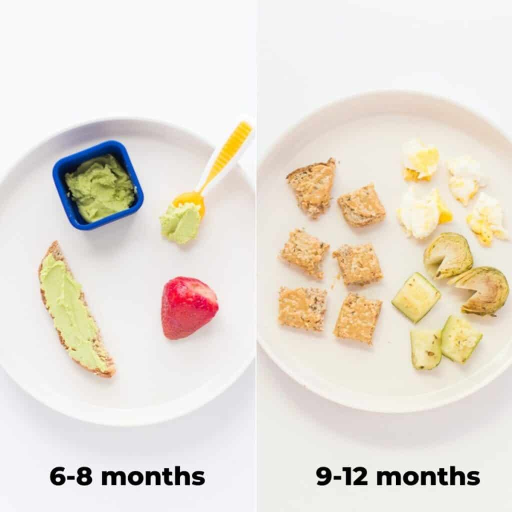 Bread for babies has to be safe and nutritious at the same time. The bread that is less sticky and more firmly baked, such as toasted whole grain or rye bread, is acceptable. These will not bond into a pasty mass in the mouth, which may cause choking. Do not use soft white bread; instead, use whole grain because it contains vitamins and fibers and helps enhance chewing muscular strength. It would be better to avoid coarsely ground bread containing seeds and nuts because they may cause allergies and choking. Ensure you introduce the bread in modest quantities to babies while watching for intolerance or allergy. For safe and healthy nutrition, the bread should be appropriate to the age and development of the child.
Bread for babies has to be safe and nutritious at the same time. The bread that is less sticky and more firmly baked, such as toasted whole grain or rye bread, is acceptable. These will not bond into a pasty mass in the mouth, which may cause choking. Do not use soft white bread; instead, use whole grain because it contains vitamins and fibers and helps enhance chewing muscular strength. It would be better to avoid coarsely ground bread containing seeds and nuts because they may cause allergies and choking. Ensure you introduce the bread in modest quantities to babies while watching for intolerance or allergy. For safe and healthy nutrition, the bread should be appropriate to the age and development of the child.
Choosing the Best Bread for Your Baby
It is essential to think about the safety and nutrition of the baby. In this case, lightly toasted bread is recommended, as it is less likely to form a gooey pulp, which can pose a choking hazard. Soft white bread must be avoided since it is almost always sticky and can block the baby's airway. The preferable types are whole grain varieties as they are not sticky and have essential vitamins and minerals such as fiber that promote health and muscles necessary for effective chewing. Nut or seed-filled bread should be avoided as they can cause choking and an allergic reaction. Gradually introduce these breads and watch for any signs of allergy/intolerance in the baby. Selecting the bread to match the child's development pace makes feeding time healthy and safe.Benefits of Lightly Toasted Bread
Gentle rules for a baby’s feeding call to understand the child and the parenting. That it is safe to introduce toasted bread into my child's diet. As a result of toasting the bread, light pressure is provided to the bread, making it less sticky and pasty, thereby reducing the danger of suffocation in babies. Not all the nutrients of whole grain options are lost during the toasting process; hence, fiber intake can be enhanced, encouraging the development of chewing muscles. Whole grain options are ideal when toasting the bread, making it a fantastic experience as they are healthy, the child can chew them, and they are very suitable for their age.Understanding Bread Contains and Potential Allergens
It is essential to avoid ingredients in the bread that will likely cause afflictions. Cross-cut studies suggest a sign of weakness regarding bread since numerous recipe ingredients mainly involve common irritants like wheat, milk, or eggs, and a few count on others being cross-contaminated by nuts or soy during the manufacturing line. I also scrutinize the relevant packaging and information on the products and assays I make to ensure I get allergen-free breads. Furthermore, I also work with the pediatrician regarding allergy tests since the evaluation enables me to address the particular needs and risks regarding the child's dietary needs. Following these steps and others boosts my confidence, knowing that all the bread options available are healthy and safe for my child.
How to Introduce Bread to Babies?
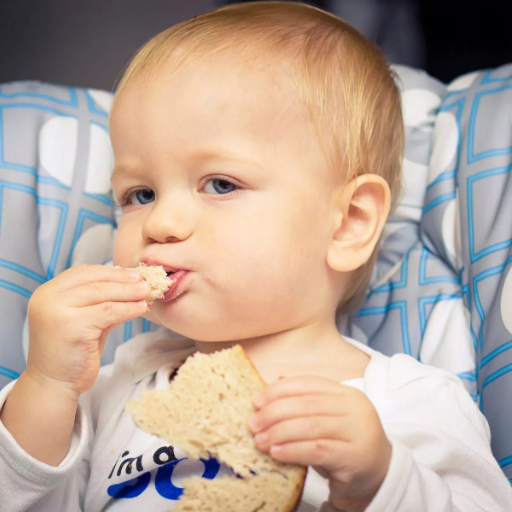 When introducing bread to babies, caution and proper timing should be prioritized. Start with a loose, toasted whole grain bread to avoid choking hazards. The bread can be cut into 1-inch (2.5 cm) strips so your baby can chew properly. Serve these pieces in portions until the baby has thoroughly chewed the pieces, and do not leave the baby unattended during mealtime. Pay attention to any signs of intolerances or allergic reactions, and take your baby to a pediatrician for that concern. Following such recommendations will ensure your baby’s developmental and nutritional needs are met without compromising their safety.
When introducing bread to babies, caution and proper timing should be prioritized. Start with a loose, toasted whole grain bread to avoid choking hazards. The bread can be cut into 1-inch (2.5 cm) strips so your baby can chew properly. Serve these pieces in portions until the baby has thoroughly chewed the pieces, and do not leave the baby unattended during mealtime. Pay attention to any signs of intolerances or allergic reactions, and take your baby to a pediatrician for that concern. Following such recommendations will ensure your baby’s developmental and nutritional needs are met without compromising their safety.
When Can Babies Eat Bread for the First Time?
In the case of babies, it is recommended that they begin to eat bread around 6 months, which is the age at which complementary feeding of the infant with either breast milk or formula can begin. We must only start giving the baby bread when the baby is developmentally prepared. To prevent choking, it is essential to ensure the bread is complex, such as softly toasted whole grain or rye. One should be careful and note any allergic or intolerant responses, mainly since bread contains wheat, which most people are sensitive to. Bread should be offered in small pieces and always be supervised during mealtime. This method makes it easy for babies to adapt to new changes so that their safety and health are not compromised.Tips for Introducing Solid Foods to Babies
To start, I look for developmental signs in my child; she usually begins around six months, when she is interested in food and can sit with support. I introduce solid foods one at a time, such as pureed vegetables or fruits, so that I can identify allergies. RI provide gradually small amounts of iron-rich foods like meat puree or iron-fortified cereals. This makes me Not unduly concerned, as my baby can take time to accept new foods and can take the food five to ten times before accepting it. The most important thing is that I am present at all mealtimes, and when I tend to feed my baby, I use safe pieces and encourage smaller bites to minimize choking accidents. Additionally, I watch the baby very closely for every new food I give to see if it causes any ill effects. This approach is systematic and cost-effective as the mother’s stress levels are minimized, and the baby is accordingly nurtured.Using Finger Foods for Easy Introduction
I begin by ensuring that from 6 months of age, my baby can sit without any support and that he shows interest in neonatal activities or hand-to-mouth movements. For the same reasons, I begin by offering soft food, such as small strips of avocado or banana, that do not pose a high risk of choking. I ensure the food provided is nutritious without hurting my child’s journey towards solid food. I’m very attentive when my child is eating, and I start new foods one at a time so that I will notice any possible allergies or unintentional reactions. This careful method allows me to keep in mind the developmental milestones of my baby and make the feeding experience safe and enjoyable for my kid.
What are the Benefits of Bread for Bread for Your Baby?
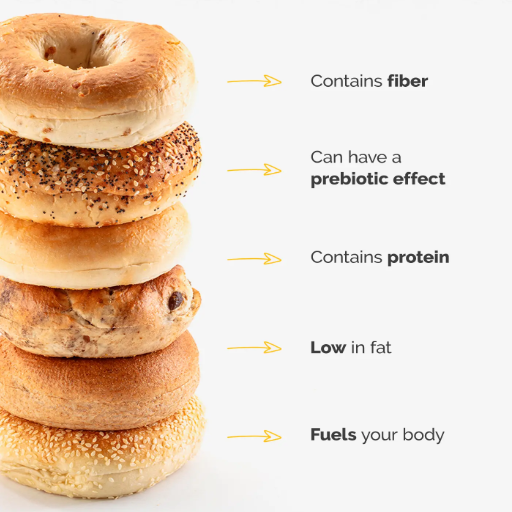 When employed correctly, bread can also have several advantages when added to your baby’s menu. First, it is a source of the critical carbohydrate that provides energy that your baby needs to perform daily tasks and is growing. Gradually, whole grain bread can offer dietary fiber, which helps digestion and increases the time it takes to introduce their baby to solids. Enriched bread can also provide iron and B vitamins essential in growth and development. Bread, when mixed with other food groups, increases the diversity and balance of your infant’s meals, enabling him or her to develop a more versatile and complex sense of taste. Always ensure that the bread is free of allergens and is introduced carefully, considering your child’s dietary restrictions and eating habits.
When employed correctly, bread can also have several advantages when added to your baby’s menu. First, it is a source of the critical carbohydrate that provides energy that your baby needs to perform daily tasks and is growing. Gradually, whole grain bread can offer dietary fiber, which helps digestion and increases the time it takes to introduce their baby to solids. Enriched bread can also provide iron and B vitamins essential in growth and development. Bread, when mixed with other food groups, increases the diversity and balance of your infant’s meals, enabling him or her to develop a more versatile and complex sense of taste. Always ensure that the bread is free of allergens and is introduced carefully, considering your child’s dietary restrictions and eating habits.
Nutritional Value of Grain Bread
Bread made of grain is quite an important food because it consists of various life-sustaining nutrients for a developing child. Whole grain bread, in particular, has a high dietary fiber content, which promotes proper bowel movements and helps in constipation avoidance. It also provides a necessary supply of carbohydrates needed as energy, meaning that the babies are also well up for their busy schedules. Furthermore, grain bread may be fortified with vitamins and minerals, including B vitamins, iron, and magnesium, necessary for biological and developmental processes. In this regard, whole grains are even linked with health promotion, including the delay of chronic illness as children mature. About grain bread, it is essential to note that the type that should be introduced should be free from any additives and allergens to ensure maximum safety and nutritional value for your baby.How Bread May Support Development
As bread is rich in nutrients, adding it to my baby’s meals can significantly benefit their growth. If you are looking for a food source containing carbohydrates needed for active and energetic play, whole grain bread would be ideal as it supports physical and cognitive growth. Additionally, the dietary fiber in grains helps with digestive health, and fortified ones provide B vitamins and iron for practical brain function and healthy blood development. The different textures of grain bread also stimulate my baby’s sensory growth when learning to grasp and chew different foods. Therefore, if I am careful about the form of the bread and do not add other unnecessary ingredients and allergens, my child will have a healthy, balanced, and safe diet.
How to Choose the Best Bread for Bread for Toddlers?
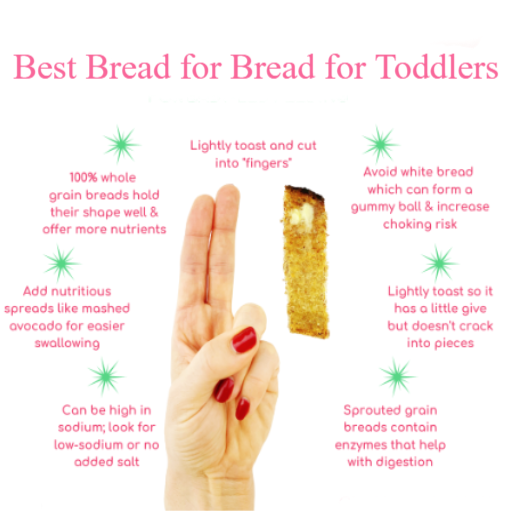 When choosing the best bread for toddlers, it is essential to consider a few primary factors to enhance both nutrition and safety. Firstly, choose whole grain bread as it contains more fiber, vitamins, and minerals than the refined types. Look for kid or toddler bread that contains no added sugars or synthetic preservatives: once again, the fewer ingredients, the better. Do note, however, that those labels may also hide allergens such as wheat or nuts, so only buy those items where such risk items are not in their history. The ideal bread should be relatively soft to minimize choking dangers and firm enough to develop chewing and oral motor skills. If possible, opt for such types of bread where iron and B vitamins have been added. When the right choices are made, you become an apparent positive player in the dietary structure of a toddler’s body and ensure that when bread is introduced, it drives the growth and health of the toddler.
When choosing the best bread for toddlers, it is essential to consider a few primary factors to enhance both nutrition and safety. Firstly, choose whole grain bread as it contains more fiber, vitamins, and minerals than the refined types. Look for kid or toddler bread that contains no added sugars or synthetic preservatives: once again, the fewer ingredients, the better. Do note, however, that those labels may also hide allergens such as wheat or nuts, so only buy those items where such risk items are not in their history. The ideal bread should be relatively soft to minimize choking dangers and firm enough to develop chewing and oral motor skills. If possible, opt for such types of bread where iron and B vitamins have been added. When the right choices are made, you become an apparent positive player in the dietary structure of a toddler’s body and ensure that when bread is introduced, it drives the growth and health of the toddler.
The Role of Sprouted Whole Grain Bread
This bread is an excellent option for toddlers looking for nutritionally dense food thanks to its unique qualities. This supports the idea that grains that sprout undergo a germination process that alters their nutrition values. Due to this shift, essential nutrients like B vitamins, vitamin C, folate, fiber, and amino acids critical in aiding a toddler’s growth and development become available in high amounts. Also, sprouted grains usually have a lesser glycemic index, which is essential in maintaining, in this case, steady blood sugar levels and sustaining energy release throughout the whole day. The improvement in digestibility allows toddlers to obtain much of the nutrients efficiently, and an increased amount of antioxidants obtained may enhance immunity. Therefore, a recommendation of this kind would be for younger toddlers to choose sprouted grain bread varieties. For example, it would help instill a solid nutritional base to enhance physical and cognitive development.Exploring Nut or Seed Butter Options
While searching for nut or seed butter for my toddler, I look for safe and highly beneficial ones. That nut butter without added sugars and additional artificial ingredients is the purest and focuses on nutrition. Almond and peanut butter have high protein and healthy fats, which is ideal for my child's energy and growth needs. Other than a handful of nuts, a variety of seed butters like sunflower or pumpkin seed butter are good for variety and nut allergies since they contain the most essential vitamins and minerals. I ensure the texture is creamy to reduce the chances of choking and ease the child into it by introducing it in small amounts and watching for any allergy signs. High-quality nut or seed butter will provide me with the opportunity to introduce new flavors and other nutrients into my toddler’s diet in a safe way.Why White Bread Might Not Be Ideal
Although its proponents claim that white bread is superior due to its light texture and sweet and creamy flavor, research studies have proved that it is more harmful to our health due to its lack of original wheat nutrients. White bread can contain simple carbohydrates as it is produced through a process known as sieving, which removes essential components of wheat such as the bran and germ. This processing leaves the wheat kernel depleted and leads white bread to have lower fiber content. So, it should come as no surprise that the majority suffers from constipation due to the active consumption of this type of bread. The removal of fibers is accompanied by the loss of several other nutrients, including B vitamins, iron, and magnesium, which are required for child development. From a technical perspective, white bread's glycemic index is higher than that of seed loaves. This has many drawbacks when looking at weight control over time, and it increases one's susceptibility to diabetes as well. Therefore, doctors recommend that a whole-seed bread loaf should be considered for improving children's long-term health, as it contains more nutrients while maintaining one’s health by enhancing fiber intake.References
Choking Bread ChildFrequently Asked Questions (FAQ)
Q: Is bread a common choking hazard for babies?
A: Yes, bread can be a choking hazard for babies, especially when served in large, soft, or sticky pieces. To reduce the risk of choking, it is important to choose the right type and preparation method.Q: When can I start serving bread to my baby?
A: You can start introducing bread to your baby around 6 months of age once they have started eating solid foods and are ready for different textures.Q: What is the best bread for babies to minimize the risk of choking?
A: The best bread for babies is often lightly toasted whole wheat or sprouted grain bread, as these are less likely to become gummy in the mouth and more accessible for babies to handle.Q: How can I safely offer bread to my baby?
A: To safely offer bread to your baby, cut it into small, manageable pieces or toast it lightly to avoid it sticking to the roof of their mouth. This helps reduce the risk of choking.Q: Can babies with food allergies safely have bread?
A: If your baby has known food allergies, consult a pediatrician before introducing bread, mainly if it contains allergenic foods like nuts or dairy. Continuously monitor for any allergic reactions when introducing new foods.Q: Is whole wheat bread healthy for babies?
A: Whole wheat bread is generally a healthy option for babies as it contains more fiber and nutrients than white bread. Ensure the pieces are small and manageable for your baby.Q: Should I avoid bread that contains added sugars or salt for my baby?
A: Yes, it is advisable for babies under 12 months to avoid bread with added sugars or high salt content to promote better health and avoid unnecessary ingredients.Q: What is baby-led weaning, and how does it relate to bread?
A: Baby-led weaning is an approach in which babies are encouraged to self-feed solid foods. Bread can be part of baby-led weaning if prepared safely, such as offering small pieces or lightly toasted slices.Q: Are there any nutritional benefits of bread for babies?
A: Bread can provide carbohydrates and fiber essential for energy and digestion. Choosing whole grain options can enhance the nutritional benefits for babies.Q: What are the best types of bread for babies and toddlers?
A: The best types of bread for babies and toddlers are whole-grain, low in added sugars, and without large seeds or nuts, which could pose a choking hazard. Sprouted grain bread is also a good option.1640






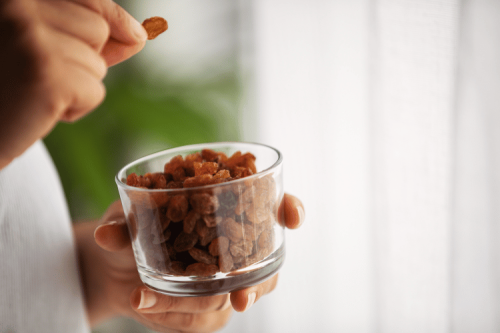

 Login with Google
Login with Google Login with Facebook
Login with Facebook